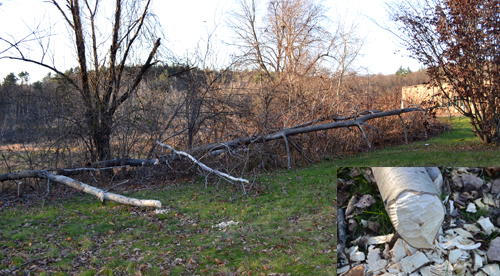

Ann Needle
By Ann Needle
After last month, it’s easy to assume the recently fallen trees in front of the former Pompositticut School are the work of Hurricane Sandy. But the cut lines reveal some dents and edge not found on human saws.
Yes, even as humans have vacated Pompo, beavers are snapping up prime real estate, tax-free, around the building.
Told of the potential activity, Animal Control Officer Susan Latham wrote off the notion that lack of humans would have anything to do with an increase in the furry tenants. Instead, Latham explained, “Beaver go where beaver go — they are not shy animals” (easy for an animal possessing fangs). “This is the time of year when beaver are chomping and storing away food for the winter. And the pond is pretty deep [in back of Pompo]; I assume there must be beaver dams in there somewhere.”
Assistant Superintendent of Streets Scott Morse agreed that it is not an empty Pompo calling to the rodents. “We’ve been trapping out of there a lot of years.”
Beaver possess cute snoods and appear on the class ring of the Massachusetts Institute of Technology — but all of this failed to impress Morse, who apparently knows what it takes to keep the creatures under control and, thus, Stow’s drains working. He estimated that beavers have been a town-wide problem for about a decade, a timeline he maintained coincides with changes in the state trapping regulations.
Massachusetts law now calls for what Morse termed “cumbersome” traps that cost about $300, but do not harm the animal. Trappers can no longer use the older, $19 leg-hold traps, which Morse conceded were a tortuous way to catch the critters. Still, Morse pointed out that the dramatically more expensive traps have severely trimmed the number of hunters seeking the animals for their pellets, which sell for about $80.
Stow recently added two of the traps to its collection of about five, Morse said. He estimated that the town traps 10 to 14 beaver annually. Once trapped, the beaver are put down. “If you move them, you’re just giving someone else your problem,” he remarked.
According to the MA Division of Fisheries and Wildlife, the beaver was almost eliminated by deforestation and vigorous hunting. There were no beaver reported in the state between 1750 and 1928 — when one was finally spotted in West Stockbridge, Even today, beaver have not been found in southeastern MA or on Cape Code, the Fisheries and Wildlife noted.
Morse said that, once the beaver population grew again, at one point the state targeted curtailing that population to about 22,000. But enter the change in the trapping laws, and the beaver population is now up to roughly 100,000, though Morse stressed he could not confirm those numbers.
What’s the Big Deal?
For those who don’t know much about why beaver do what they do, keep in mind what Morse said: “They’re all about winter and survival and taking care of their kits.” To build a lodge for the winter, and to prepare for the birth of kits, the beaver works tirelessly to clear a home by the water, where it can safely dive and swim from predators. The cleared vegetation (including the inner bark of those Pompo trees) will help feed the kits, which usually stay with the parents about two years, he noted.
In this process, the beaver dam up the water to make a deep, safe place to live, one that wards off most land predators. The overflow often causes those famed drainage backup. (To be fair, Fisheries and Wildlife mentioned that beavers also create valued wetlands this way.)
“But they’re not a problem for everyone,” Morse emphasized. Naturally, homeowners near low-lying water sources are more prone to beaver damage. Morse named the Stow trouble spots as Delaney Pond, the pond by Pilot Grove, and the Lions Club field.
And, because beaver move downstream, Morse noted that Stow has more trouble with the animals than some, as it is downstream from most nearby towns.
While beaver are aggressive about staking space, they also can pull swift disappearing acts if approached by humans or other predators, and do not stray much from their protective water. The fact that they appear to have been out in the open in front of Pompo is a sure sign of overcrowding, said Morse.
“If they’re going as far out of the water as they are down at Pompo, then they’re really hungry and really over-populated,” he observed. “Anything that’s going to get them will get them away from the water.”